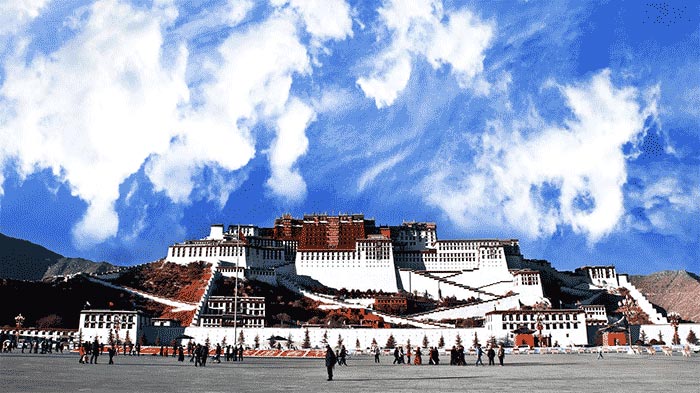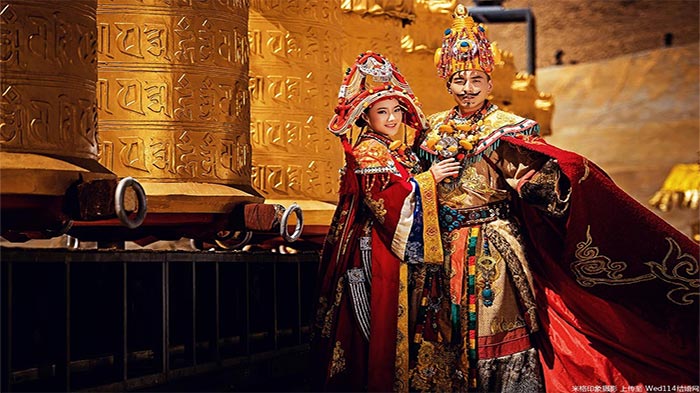
History of Potala Palace: Legendary, Stories...All You Need to Know for History Buffs
The history of Tibet is here. History, architecture and mystery…Potala Palace (3700m), the treasure house of Tibetan culture and history, has enough reasons to be the fantasy for every history buff. Perched on Red Hill, the landmark of Tibet dominates Lhasa with incredible architecture.
For years, it has remained one of the focal points of religious pilgrimage and the top highlight of Tibet tour. Through the white-washed marble stairs, magnificent walls of the palace, and loads of religious treasure and secret chambers inside, Potala Palace keeps whispering the timeless stories of glorious Tibetan history.
Potala Palace Facts
Potala, which means the residence of Guanyin(Bodhisattva) in Sanskrit, is a symbol of compassion and wisdom in Buddhism and has a very important position in folk beliefs. It was first built in 7th century AD, 1,300 years ago, located in the northwest on the Red mountain, has a total of 999 rooms. The overall building stands an altitude of 3,700 meters, use total area 9927 square meters, and the main building is 117 meters high with 13 floors. Although time changes, this pearl still is the center of Lhasa. People keep going to worship, like only this magnificent building can purify them.
 Potala Palace under the beautiful sky
Potala Palace under the beautiful sky
Constructions of Potala Palace
Who has seen the Potala Palace will be surprised and wonder what kind of structure can hold it stand on the Red Hill for hundreds even thousands of years.
It consists of the White Palace in the east, the Red Palace in the middle. In front of the Red Palace, there is a white towering wall for hanging large Buddha tapestry on Buddhist festivals The base exterior wall is 2~5 meters thick, and the foundation straightly buried into rocks, because of material choose (granite) and mixed with iron, it is strong enough to survive till today.
In 7th century AD, the Tubo emperor Songtsen Gampo gave orders to build a great palace on Red Mountain, name it “Potala”, means “the holy place” in Sanskrit, in order to marry a noble princess Wencheng from Tang Dynasty. The initial Potala was a nine-story building which has 1,000 rooms, the walls were ten meters high and mixed with watering iron to reinforce.
After two hundred years, with the perdition of Tubo Dynasty, many palaces were damaged during wars in 9th century AD, there were only two houses left.
Until 17th century AD, Dalai Lama V came to power, he commanded rebuilding the palace immediately. And it took three years to build the White Palace, the east part of the Potala Palace. Dalai Lama V had lived in the White Palace since then.
Dalai Lama V died in 1682, the king followed his will, hided his death and continued to build the palace in 1690, three years later, Red Palace completed.
The Potala Palace had been continued expanding in the next three hundred years, mainly are the spiritual tower of generations of the Dalai Lama, include the East Sushine Apartment built by Dalai Lama XIII.
Legendary Stories of Potala Palace and its Residents
The Potala Palace has experienced thousands of ups and downs, there must be some attractive stories, among them, Songtsen Gampo, Dalai Lama V and Dalai Lama VI are most famous.
Songtsen Gampo
In Tubo Dynasty, the young emperor, Songtsen Gampo, who took crown when only 13 years old as his father was poisoned by others, he put down the rebellions inside and resisted invasion outside, eventually reached the unification of Tubo. At that time, the placid land was eager for economic development and advanced techniques. When it became more thriving and prosperous, the emperor Songtsen Gampo asked for a wife from the most powerful country, Tang Dynasty, but was refused.
After several tries, the “Agree” news surprised him, and he later built a palace to welcome Princess Wencheng, who brought Shakyamuni’s 12-year-old statue but also civilization in, no doubt that this princess poured fresh water into this land, who had been loving by citizens during her whole life.
Travel Tips: If you want to learn more of the legendary story between Princess Wencheng and Songtsen Gampo, luckily we can offer tourist-friendly services for you to watch the Wencheng real-scene musical in Lhasa. It would be a perfect cultural experience for you and your family.
 The stage play of Princess Wecheng entering the Tibet
The stage play of Princess Wecheng entering the Tibet
Dalai Lama
In history, the title Dalai Lama is supreme leader of Tibetan monks in Tibetan Buddhism in Tibet. Dalai Lamas often stay in Jokhang Temple, but in winter, the Potala Palace become their residence, from Dalai Lama V to XIIII.
At first, Potala Palace’s function only as the living place for noble people, but as mentioned above, it’s Dalai Lama V who rebuilt the Potala, at the same time, a great number of lamas came in, the Potala truly became the holy palace of politics and religion. Meanwhile, Potala Palace has an irreplaceable place in Tibetans’ hearts, religiously and culturally, only next to Jokhang Temple.
After the death of Dalai Lama V, the king gave orders to look for the reincarnated boy (who born at almost the same time when the last Dalai Lama dead), so that if the truth is revealed in the future, they can also immediately welcome the Dalai Lama VI to the Palace.
The Rebellious Dalai
In 1697, Tsangyang Gyatso, the VI, came in the Palace and started learning a variety of rules and regulations, but never got used to. Though he is the Dalai, powers are in the hands of others, he is just a puppet. The VI can only express himself in the poetry (who is one of the most famous poets in China). He is also the first and only Dalai who was impeached (victim of political conflict), and died on the way to court.
Precious Cultural Relics and Religious Sites in Potala Palace
According to statistics, over 7000 treasures are in Potala , carvings and murals (nearly 200 people had participated in the mural painting, took more than ten years to complete. Including the history of the development of Tibetan Buddhism, the life of Dalai Lama XV, and the progress of princess Wencheng entering Tibet) are approximately 2,500 square meters. Even a sentence goes by people: the most worthless in Potala is, GOLD.
Shol Village
As you enter Potala Palace’s compound, the first attraction you might ignore is called Shol Village or Shol garden at the foot of Potala Palace. Going to this community, we will know how Tibetan people live in the past.
One must-see attraction is the Treasures Hall, a three-story building with a significant national character of Tibetan people. In 2000, the vice premier came and suggested to build an exhibition hall for people to visit those priceless treasures, and said it would be a shame if those things under the lights forever. There are more than 200 treasures take turns in exhibition now, don’t miss it.
White Palace
The East Courtyard locates in east of White Palace, A drum made of horse skin hanging in the entrance, reminded the time of old Tibet in Potala. Every day after the drums (21:00 in local time, 23:00 in Beijing time), walking and talking loudly will be forbidden in the palace.
The West Sunshine Apartment is built by Dalai Lama V when expanded the Palace, the East Sunshine Apartment, however, was built much more late, by Dalai Lama XIII. Both apartments enshrine and worship a large amount of exquisite Buddhist statues, pagodas with precious stones, also, murals pained by natural pigment, we will see them along this trip.
Through the East Sunshine Apartment is the front entrance of Potala Palace. From 12th floors to the wooden staircase, we reach the gateway. Even is the entrance, there are four heavenly Kings Murals on the western wall. The north wall is the panorama of the front of the Potala Palace in 7th century AD, Songtsen Gampo’s time. And on the east, paint the capital city, Changan in early Tang dynasty.
 Main Entrance of White Palace
Main Entrance of White Palace
Red Palace
Middle one is always important. The Red Palace also being used to preserve Dalais’ and Buddha’s statues. Among them, the statue of Dalai Lama V is the first and biggest one, cost 550 kilogram gold just to cover the tower (where preserve Dalais’ body after antiseptic progress ). The tower stays in the West Chapel today, also the biggest chapel in Red Palace, where preserve a marvelous curtain of brocade , the priceless treasure which was given by Qianlong emperor in Qing Dynasty, it took a total year to complete.
The Maitreya Chapel stands the east of the top of Red Palace, the Maitreya(known as the future Buddha), except the golden Maitreya statue, bookshelves around the Chapel preserve hundreds of Buddhist scriptures. The Chapel suffered a fire accident on 19th of June, 1984, due to a short circuit of electric wires, so what we can see now is partially repaired.
When go through the Maitreya Chapel, stand on the roof of the Red Palace, we get the beautiful view of Golden Roofs, however, tourists only allowed to see in distance.
On the west side of Red Palace, the Chapel of Dalai Lama V, built between 1690 and 1693, is a four-storey building in appearance and also the most famous Chapel of the Potala. The spiritual towers of Dalai V,X,XII are in this Chapel, and there are eight Buddha’s pagodas, all represent different meanings. Every treasure is covered with priceless gems from years ago.
The Chapel of Dalai Lama XIII located between the red palace and zasha (monastery). The murals on third-floor is the most precious one ,with more than 200 sets of images depicting the whole life of Dalai Lama XIII, Thubten Gyatso. The volume and the height of this tower are the most among eight Dalai Lamas’. Numbers of inlaid precious stones are the sum of the other seven. It’s the most exquisite and luxurious pagoda of the Dalai Lamas’.
Potala always impresses and astonishes tourists, not only the countless treasures but also the Tibetan culture inside itself, truly a precious historical scroll painting.
Join-in Classic Lhasa Tours

Energetic, responsible and reliable, Sonam is a guide with more than seven years experience informing visitors about heritage sites and attractions places in Tibet.


.jpg)


0 Comment ON "History of Potala Palace: Legendary, Stories...All You Need to Know for History Buffs"